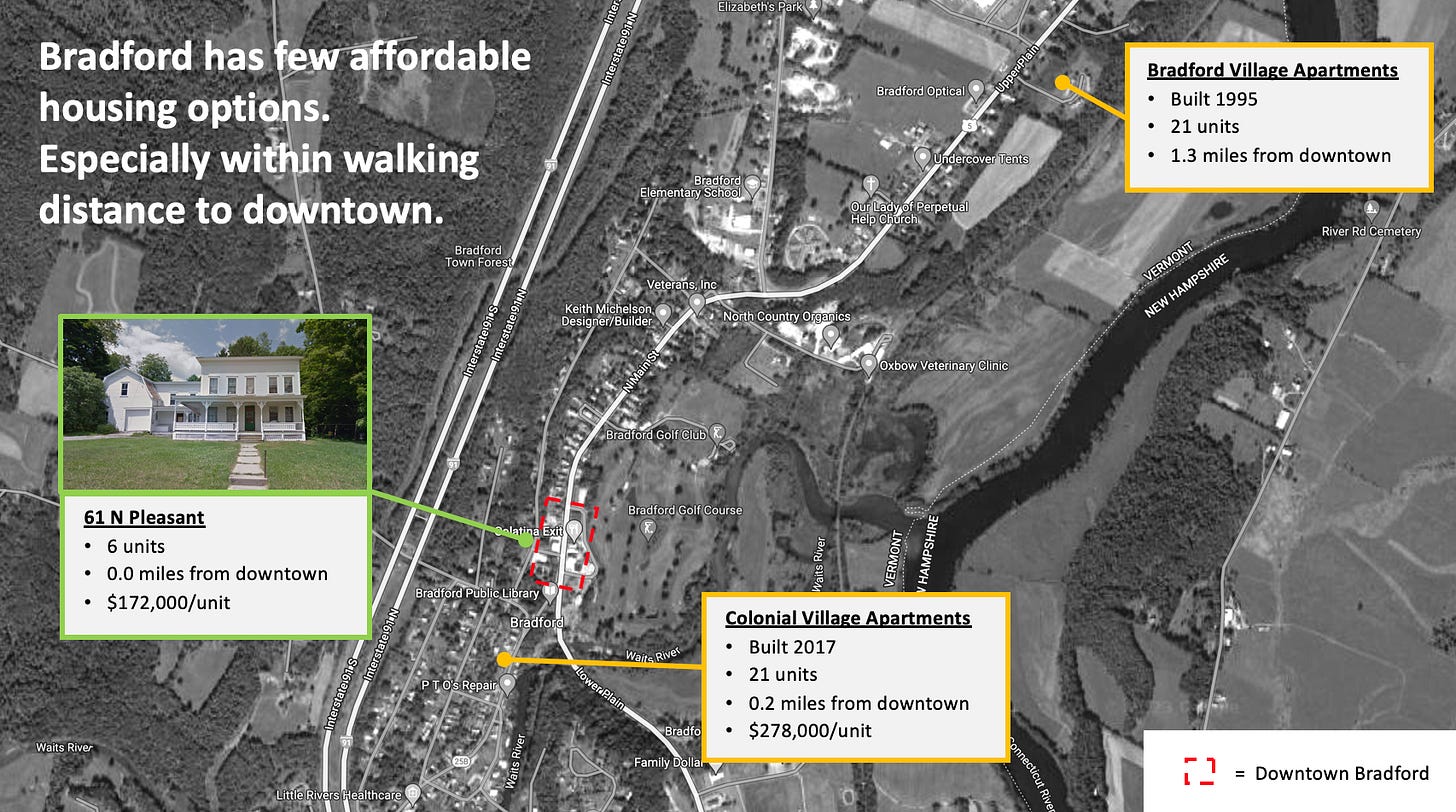Funding A Small-Scale Affordable Housing Project
A $650,000 grant closes the funding loop on my next project: a 6-unit affordable housing conversion.
Hey — Jonah here. This is Brick + Mortar where I share insight into the acquisition, financing, design, construction, and operations of small-scale real estate development projects.
Exciting news to share!
As 501 Main starts to wrap up, I’m now also focusing on my next project.
Enter 61 N Pleasant in Bradford, VT.
I’ve owned the property since 2021 and have already have it entitled for six apartments (currently a 3700 sf house and barn).
The past six months have been dedicated to closing the funding loop. And, given my goal to keep 100% of the units affordable, this requires significant grant funding.
You might remember a few posts I shared on the struggles of getting a small-scale project to mesh with traditional affordable housing programs (here and here).
Well—last week the project was awarded a $650,000 grant, adding to another $220,000 in grants already secured. This new award is through the Vermont Housing & Conservation Board’s (VHCB) ARPA-SFR program.
In exchange, apartments will be rented at 50-70% AMI in perpetuity.
So now, with the funding loop closed, we can move forward with pre-con activities (A&E, permitting, bidding, etc).
A quick look at our capital stack and planned uses:
I was (still am) shocked by this award.
I didn’t expect a small-scale project like this to get the time of day from the state agency in charge of administering funding.
I’m happy to have been proven wrong.
Here are two takeaways from my experience investing 100+ hours over the past six months trying to fund a small-scale affordable housing project:
Takeaway #1: Too few programs exist for small-scale affordable housing development
The majority of affordable housing programs are geared exclusively towards larger developments.
For example, my application to the Upper Valley Loan Fund was rejected on the basis that it didn’t meet their 30-unit minimum requirement.
Yet, larger projects don’t always fit within the context of Vermont’s village centers. Small, infill projects do.
And, so—when I was given 15 minutes to present my project to the VHCB board, I showed a single slide:
Most obvious is that the town lacks affordable housing in general.
Even more acute is its absence downtown where traditional affordable housing patterns don’t quite fit the character of the area.
Smaller, infill opportunities are everywhere though. Colonial Village is actually a great example of this—3 or 4 clustered buildings that reflect the architecture of the surrounding properties.
That said—the landscape for small-scale (sub 20-unit) affordable programs is sparse.
And while it’s great to see VHCB demonstrating a progressive effort to help level the playing field, they only award a handful of grants every quarter.
We need more programs out there for small-scale projects to take advantage of. Otherwise, developers will continue to focus on market rate units out of necessity.
Takeaway #2: Don’t be afraid to ask
A month after I submitted my VHCB application last October, I received a reply saying I was missing a number of documents.
This included a Phase I ESA, capital needs assessment, market study, etc.
Documents that, in total, cost $20,000+ to prepare.
This is a good amount of capital to put at risk before an award decision is made. And, as a small-scale developer with a shoestring budget, I can’t afford to lose $20,000+.
So I tried getting creative:
What if the Phase I was conducted after an award decision? The building has been a single-family home since 1900, surrounded by similar vintage homes. Risk of environmental contamination is low
Could I have my architect vet the construction budget I prepared vs having a full 3rd-party cost estimate conducted?
Instead of a market study specific to this project, can we leverage other existing market studies to quantify demand?
It worked.
VHCB showed some flexibility.
Instead of putting $20,000+ at risk, I put up $0 and a ton of sweat equity finding alternatives to satisfy the requirements.
Granted, all of the postponed items still have to be completed. But it’s a much easier pill to swallow knowing funding is secured and the project will move forward.
For reference, here’s the list of documents required alongside a VHCB ARPA-SFR application:
There was a moment when I read that first response from VHCB citing the plethora of missing documents where I almost gave up.
Partly because it was clear the program was not intended for 6-unit projects with tighter budgets. And also because I knew I didn’t have the funds to shell out for the upfront assessments.
Lesson learned.
It never hurts to ask.
Until next time.
— Jonah 🧱
P.S. View from above 61 N Pleasant, looking towards downtown and the golf course.









Congrats Jonah!
Woo hoo, congrats on the grant and thanks for serving notice about the lack of assistance available for these kinds of important projects!